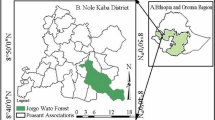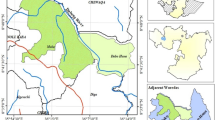Abstract
Woody plant encroachments are major concerns across the grasslands biome, while the patterns of individual species existence at a landscape level can be limited locally and regionally. The paper assesses the species composition, community structure, and density of individual and combined encroacher woody species in terms of tree equivalent per hectare (TE ha−1) within five different height classes at four elevation levels in Borana arid thorn bush savanna grasslands in Southern Ethiopia. At each elevation class, a grid of 20 × 20 m main plot was placed, and samples were collected randomly from three 100 m2 sub-plot within the main plot. Using a single-factor analysis of variance, the effects of four elevation classes were considered on encroacher woody plant species composition, total, and individual density (TE ha−1) within height classes. A total of 22 encroacher woody plant species composition were identified. The identified woody plants are seemingly a threat to the Borana rangelands of Southern Ethiopia with various patterns of distribution and density (TE ha−1) among the different elevation levels. Of the identified species, Acacia reficiens had the highest density (1052.22 ± 265.34 TE ha−1) at elevation level II. The most important encroaching species in each elevation level was varied considerably, while the combined woody plants density (TE ha−1) within height classes across elevation levels showed minimal variations. This suggests that the management of a specific ecological site might require greater focus in terms of the functional traits of individual woody species composition, density coverage within height classes, and community structure. Hence, identifying the patterns, distribution, and density of encroaching woody species is crucial for the control of key encroacher woody species at a landscape level.




Similar content being viewed by others
Data availability
Data for this manuscript were collected through field vegetation sampling and observation in the field.
References
Abule E (2008) Bush encroachment: a major threat to pastoralists’ livelihood in Ethiopia. The 21st International Grassland Congress/8th International Rangeland Congress, Hohhot, China, June 29 through July 5, 2008. Proceedings edited by Organizing Committee of 2008 IGC/IRC Conference Published by Guangdong People’s Publishing House
Andela N, Liu YY, Van Dijk AIJM, De Jeu RAM, McVicar TR (2013) Global changes in dryland vegetation dynamics (1988-2008) assessed by satellite remote sensing: comparing a new passive microwave vegetation density record with reflective greenness data. Biogeosciences 10(10):6657–6676
Angassa A (2014) Effects of grazing intensity and bush encroachment on herbaceous species and rangeland condition in Southern Ethiopia. Land Degrad Dev 25(5):438–451
Angassa A, Oba G (2008) Herder perceptions on impacts of range enclosures, crop farming, fire ban and bush encroachment on the rangelands of Borana, Southern Ethiopia. Hum Ecol 36(2):201–215
Angassa A, Oba G (2007) Relating long-term rainfall variability to cattle population dynamics in communal rangelands and a government ranch in Southern Ethiopia. Agric Syst 94(3):715–725
Archer SR, Andersen EM, Predick KI, Schwinning S, Steidl RJ, Woods SR (2017) Woody plant encroachment: causes and con-sequences. In: Rangeland systems: Processes, Management and Challenges (David, E., and Briske, D., eds) Springer, Cham, pp. 25–84
Austin MP, Pausas JG, Nicholls A(2010) Patterns of tree species richness in relation to environment in southeastern New South Wales Aust J Ecol 21(2):154–164.
Bille JC, Eshete A, Corra M (1983) Ecology and ecosystems of the Borana deep wells area. ILCA, Addis Ababa, Ethiopia
Bucini G, Hanan NP (2007) A continental‐scale analysis of tree cover in African savannas. Glob Ecol Biogeogr 16(5):593–605
Burnham AK, Stubblefield CT, Campbell JH (1980) Effects of gas environment on mineral reactions in Colorado oil shale. Fuel 59(12):871–877
Chang XY, Chen BM, Liu G, Zhou T, Jia XR, Peng SL (2015) Effects of climate change on plant population growth rate and community composition change. PloS ONE 10(6):e0126228
Colwell RK, Lees DC (2000) The mid-domain effect: geometric constraints on the geography of species richness. Trends Ecol Evolution 15(2):70–76
Coppock DL (2016) Pastoral system dynamics and environmental change on Ethiopia’s north-central Borana Plateau—influences of livestock development and policy. In The end of desertification? Springer, Berlin, Heidelberg, p 327–362
Coppock DL (Ed.) (1994) The Borana plateau of Southern Ethiopia: synthesis of pastoral research, development, and change, 1980-1991. International Livestock Centre for Africa, Addis Ababa, Ethiopia, p 1994
Cossins NJ, Upton M (2007) The Borana pastoral system of Southern Ethiopia. Agric Syst 25(3):199–218
Dalle G, Maass BL, Isselstein J (2010) Encroachment of woody plants and its impact on pastoral livestock production in the Borana lowlands, southern Oromia, Ethiopia. Afr J Ecol 44(2):237–246
Dalle G, Maass BL, Isselstein J (2006) Rangeland condition and trend in the semi-arid Borana lowlands, southern Oromia, Ethiopia. Afr J Range Forage Sci 23(1):49–58
DOWWE (Design Oromia Water Works & Supervision Enterprise) (2010). The National Regional State of Oromia, Oromia Land and Environmental Protection Bureau. Borana Land Use Planning Study Project. (Unpublished)
Eldridge DJ, Bowker MA, Maestre FT, Roger E, Reynolds JF, Whitford WG (2011) Impacts of shrub encroachment on ecosystem structure and functioning: towards a global synthesis. Ecol Lett 14(7):709–722
Eviner VT, Garbach K, Baty JH, Hoskinson SA (2012) Measuring the effects of invasive plants on ecosystem services: challenges and prospects. Invasive Plant Sci Manag 5(1):125–136
Friedel MH (1987) A preliminary investigation of woody plant increase in the western Transvaal and implications for veld assessment. Proceedings of the Annual Congresses of the Grassland Society of Southern Africa, 4(1), 25–30
Gillson L, Hoffman MT (2007) Ecology. Rangeland ecology in a changing world. Science 315:53–54
Girma A (2012) Plant communities, species diversity, seedling bank and resprouting in Nandi forests, Kenya
Hegazy AK, Lovettdoust J, Hammouda O, Gomaa NH (2007) Vegetation distribution along the altitudinal gradient in the northwestern Red Sea region. Community Ecol 8(2):151–162
Henricksen BL (1986) Reflections on drought: Ethiopia 1983-1984. Int J Remote Sens 7(11):1447–1451
Holechek JL, Pieper RD, Herbel CH (1995) Range management principles and practices, 2nd edn. Prentice-Hall, Deceased, New Mexico, State University, Las Cruces
Hubbell SP (2001) The unified neutral theory of biodiversity and biogeography (MPB-32), vol 32. Princeton University Press, Princeton, New Jersey
Hundera K, Gadissa T (2008) Vegetation composition and structure of Belete Forest, Jimma Zone, South Western Ethiopia. Biol Soc Ethiopian 7(1):1–15
Lechmereoertel RG et al. (2005) Patterns and implications of transformation in semi-arid succulent thicket, South Africa. J Arid Environ 62(3):459–474
Liao C, Fei D (2017) Pastoralist adaptation practices under non-governmental development interventions in Southern Ethiopia. Rangel J 39(2):189–200
Liao C, Clark PE, De Gloria SD (2018) Bush encroachment dynamics and rangeland management implications in Southern Ethiopia. Ecol evolution 8(23):11694–11703
Maestre FT, Quero JL, Gotelli NJ et al. (2012) Plant species richness and ecosystem multifunctionality in global drylands. Science 155(6065):214–218
Mitchard ETA, Flintrop C (2013) Woody encroachment and forest degradation in sub-Saharan Africa’s woodlands and savannas 1982–2006. Philos Trans R Soc Lond 368(1625):20120406
O’Connor TG, Puttick JR, Hoffman MT (2014) Bush encroachment in southern Africa: changes and causes. Afr J Range Forage Sci 31(2):67–88
Oba G, Kotile D (2001) Assessments of landscape level degradation in Southern Ethiopia: pastoralists versus ecologists. Land Degrad Dev 12(5):461–475
Oba G, Post E, Syvertsen PO, Stenseth NC (2000) Bush cover and range condition assessments in relation to landscape and grazing in Southern Ethiopia. Landsc Ecol 15(6):535–546
Paudel S, Vetaas OR (2014). Effects of topography and land use on woody plant species composition and beta diversity in an arid Trans-Himalayan landscape, Nepal. J Mt Sci 11(5). https://doi.org/10.1007/s11629-013-2858-3
R Development Core Team (2019) R: A language and environment for statistical computing. R Foundation for Statistical Computing, Vienna, http://www.R-project.org.
Roques KG, O’Connor TG, Watkinson A (2001) Dynamics of shrub encroachment in an African savanna: relative influences of fire, herbivory, rainfall and density dependence. J Appl Ecol 38(2):268–280
Shiferaw D, Kelbessa E, Soromessa T (2011) Vegetation structure and regeneration status of Anbesa Chaka lowland bamboo forest, Western Ethiopia. Ethiopian. J Biol Sci 10(1):19–38
Van Auken O (2009) Causes and consequences of woody plant encroachment into western North American grasslands. J Environ Manag 90(10):2931–2942
Van Dyne GM (1966) Ecosystems, systems ecology, and systems ecologists (No. ORNL-3957). Oak Ridge National Lab, TN
Van Wijngaarden W (1985) Elephants, trees, grass, grazers: relationships between climate, soils, vegetation, and large herbivores in a semi-arid savanna ecosystem. Doctoral dissertation, Landbouwhogeschool te Wageningen, Tsavo, Kenya
Vetter S (2005) Rangelands at equilibrium and non-equilibrium: recent developments in the debate. J Arid Environ 62(2):321–341
Vilà M, Ibáñez I (2011) Plant invasions in the landscape. Landsc Ecol 26.4:461–472
Acknowledgements
We thank the local community and staff members of Pastoral Development Office of Dubluk, Dirre, and Dillo districts for their kind support during data collection and the University of Chinese Academy of Sciences, Beijing, and National Engineering Technology Research Center for Desert-Oasis Ecological Construction, Xinjiang Institute of Ecology and Geography, Chinese Academy of Sciences, Urumqi, Xinjiang, China.
Funding
This study received financial support from National Key Research and Development Program of China-Joint Research on Technology to Combat Desertification for African Countries of the “Great Green Wall” (No. 2018YFE106000); Projects of International cooperation and Exchanges NSFC (Grant No. 41861144020); Science and Technology Partnership Program, Ministry of Science and Technology of China (Grant No. KY201702010).
Author Contributions
Conceptualization and methodology: ZB and AA. Formal analysis and investigation: ZB. Writing (original draft preparation): ZB. Writing (review and editing): ZB, AA, YW and YY. Resources and Supervision: XX. All authors read and approved the final manuscript.
Author information
Authors and Affiliations
Corresponding authors
Ethics declarations
Conflict of Interest
The authors declare no competing interests.
Additional information
Publisher’s note Springer Nature remains neutral with regard to jurisdictional claims in published maps and institutional affiliations.
Supplementary Information
Rights and permissions
About this article
Cite this article
Bora, Z., Angassa, A., Wang, Y. et al. Effect of Elevation on the Density and Species Composition of Encroacher Woody Plants in Borana Rangeland, Southern Ethiopia. Environmental Management 67, 1075–1087 (2021). https://doi.org/10.1007/s00267-021-01458-x
Received:
Accepted:
Published:
Issue Date:
DOI: https://doi.org/10.1007/s00267-021-01458-x




